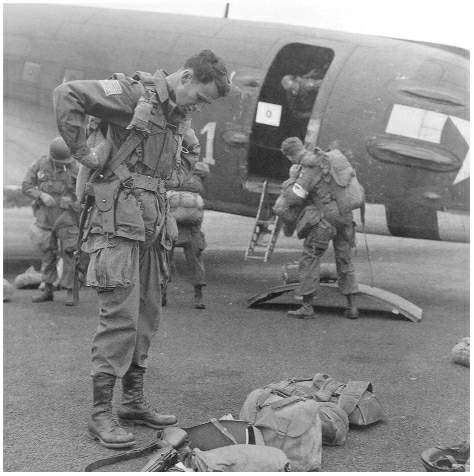General Gavin jumped with his men and led from the front. Here he is ‘chuting up for the D-Day jump, note his preferred weapon, a rifle.
In November 1943, as the bulk of the 82nd Airborne Division prepared to leave the Mediterranean, General James M. Gavin had already gone to London to help plan the airborne part of the forthcoming invasion of France. The soldiers, after months in warm climes, were shortly to find themselves in Northern Ireland in winter. There might not be anyone shooting at them there, but the change from southern to northern European weather was certainly going to test their hardiness. The 82nd had suffered terrible casualties and was going to need some time to get back to full strength. It had also proved beyond doubt the value of the Airborne and that meant the call would not be long in coming.
The division was not to stay in Ireland for long. Early in the New Year a more permanent facility was set up near Leicester. To make up strength the 507th and 508th PIRs were now assigned to the division. Additionally volunteers were sought amongst suitably qualified replacement troops arriving from the US-in most cases only too happy to leave the miserable tented camps in the dank Welsh countryside they were ‘holding’ in. A jump school was established near Leicester to qualify those not previously parachute trained, and training at all levels was stepped up.
The nine months spent in England were generally happy ones for the troopers. They found that they had much in common with their British counterparts and, of course, there was a social life. The locals were for the most part welcoming and friendly, the girls pretty and the beer, if unfamiliar to American tastes, was good. Again from the modern perspective, it should be remembered that many of the troopers had known nothing of the world outside a farm in Nebraska or Tennessee a few months before.
Another important step came in England. The glidermen, long denied parity with the paratroops they so ably supported, finally received their pay increase and their own wings. No one truly begrudged it-jumping was always regarded as far safer than going by glider.
As the intensive training continued, so did the build-up of men and material for the invasion. Over 2,000 Waco gliders were shipped to the UK and assembled. In order that the 101st should benefit from the combat experience of the 82nd Gavin was put in charge of standardising tactics and procedures throughout the Airborne.
The British Isles became a vast hive of military activity as every arm of service from dozens of nations prepared for the biggest invasion in history. The Reich was pounded by the RAF at night and by the US Army Air Force during the day. Every possible logistic need was considered, huge floating harbours and fuel pipelines were devised; new equipment was developed and tested and assaults from the sea and air rehearsed. Occasionally the exercises were all too real. Terrible slaughter was wrought off the Dorset coast one night when German E-Boats got in amongst landing craft full of troops. (Kept secret at the time lest it effected morale, the disaster at Siapton Sands has only recently been fully reported.)
There were problems at the top, too. For all the public unity amongst the Allies there were disagreements and conflicting agendas, both political and military. Later on this was to cost the Airborne dear. For the time being a consensus was eventually reached, and planning for Operation Overlord went into the final stages. Gavin rejoined the division on 6 February.
